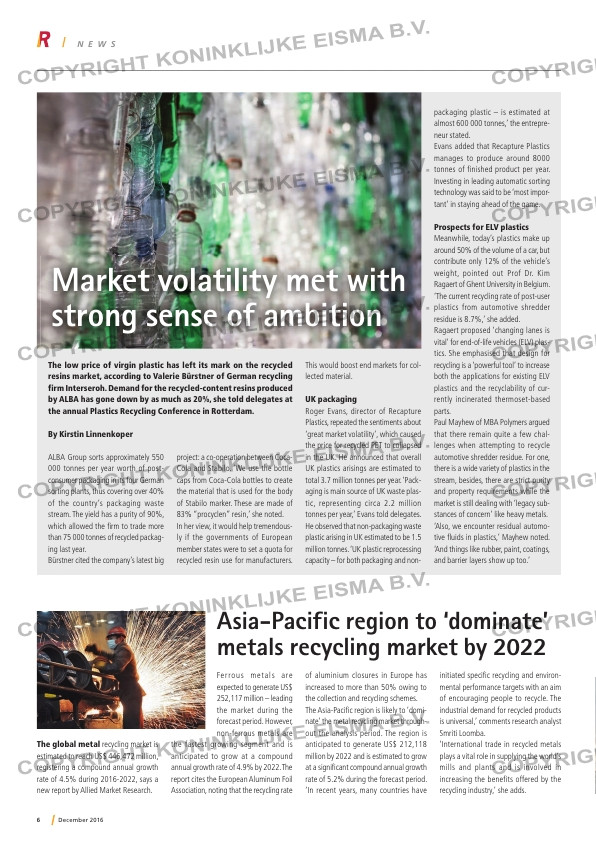Page 6 from: December 2016

6 December 2016
N E W S
The low price of virgin plastic has left its mark on the recycled
resins market, according to Valerie Bürstner of German recycling
firm Interseroh. Demand for the recycled-content resins produced
by ALBA has gone down by as much as 20%, she told delegates at
the annual Plastics Recycling Conference in Rotterdam.
By Kirstin Linnenkoper
ALBA Group sorts approximately 550
000 tonnes per year worth of post-
consumer packaging in its four German
sorting plants, thus covering over 40%
of the country’s packaging waste
stream. The yield has a purity of 90%,
which allowed the firm to trade more
than 75 000 tonnes of recycled packag-
ing last year.
Bürstner cited the company’s latest big
project: a co-operation between Coca-
Cola and Stabilo. ‘We use the bottle
caps from Coca-Cola bottles to create
the material that is used for the body
of Stabilo marker. These are made of
83% “procyclen” resin,’ she noted.
In her view, it would help tremendous-
ly if the governments of European
member states were to set a quota for
recycled resin use for manufacturers.
This would boost end markets for col-
lected material.
UK packaging
Roger Evans, director of Recapture
Plastics, repeated the sentiments about
‘great market volatility’, which caused
the price for recycled PET to collapsed
in the UK. He announced that overall
UK plastics arisings are estimated to
total 3.7 million tonnes per year. ‘Pack-
aging is main source of UK waste plas-
tic, representing circa 2.2 million
tonnes per year,’ Evans told delegates.
He observed that non-packaging waste
plastic arising in UK estimated to be 1.5
million tonnes. ‘UK plastic reprocessing
capacity – for both packaging and non-
packaging plastic – is estimated at
almost 600 000 tonnes,’ the entrepre-
neur stated.
Evans added that Recapture Plastics
manages to produce around 8000
tonnes of finished product per year.
Investing in leading automatic sorting
technology was said to be ‘most impor-
tant’ in staying ahead of the game.
Prospects for ELV plastics
Meanwhile, today’s plastics make up
around 50% of the volume of a car, but
contribute only 12% of the vehicle’s
weight, pointed out Prof Dr. Kim
Ragaert of Ghent University in Belgium.
‘The current recycling rate of post-user
plastics from automotive shredder
residue is 8.7%,’ she added.
Ragaert proposed ‘changing lanes is
vital’ for end-of-life vehicles (ELV) plas-
tics. She emphasised that design for
recycling is a ‘powerful tool’ to increase
both the applications for existing ELV
plastics and the recyclability of cur-
rently incinerated thermoset-based
parts.
Paul Mayhew of MBA Polymers argued
that there remain quite a few chal-
lenges when attempting to recycle
automotive shredder residue. For one,
there is a wide variety of plastics in the
stream, besides, there are strict purity
and property requirements while the
market is still dealing with ‘legacy sub-
stances of concern’ like heavy metals.
‘Also, we encounter residual automo-
tive fluids in plastics,’ Mayhew noted.
‘And things like rubber, paint, coatings,
and barrier layers show up too.’
Asia-Pacific region to ‘dominate’
metals recycling market by 2022
The global metal recycling market is
estimated to reach US$ 446,472 million,
registering a compound annual growth
rate of 4.5% during 2016-2022, says a
new report by Allied Market Research.
Fer rous meta ls are
expected to generate US$
252,117 million – leading
the market during the
forecast period. However,
non-ferrous metals are
the fastest growing segment and is
anticipated to grow at a compound
annual growth rate of 4.9% by 2022. The
report cites the European Aluminum Foil
Association, noting that the recycling rate
of aluminium closures in Europe has
increased to more than 50% owing to
the collection and recycling schemes.
The Asia-Pacific region is likely to ‘domi-
nate’ the metal recycling market through-
out the analysis period. The region is
anticipated to generate US$ 212,118
million by 2022 and is estimated to grow
at a significant compound annual growth
rate of 5.2% during the forecast period.
‘In recent years, many countries have
initiated specific recycling and environ-
mental performance targets with an aim
of encouraging people to recycle. The
industrial demand for recycled products
is universal,’ comments research analyst
Smriti Loomba.
‘International trade in recycled metals
plays a vital role in supplying the world’s
mills and plants and is involved in
increasing the benefits offered by the
recycling industry,’ she adds.
Market volatility met with
strong sense of ambition



